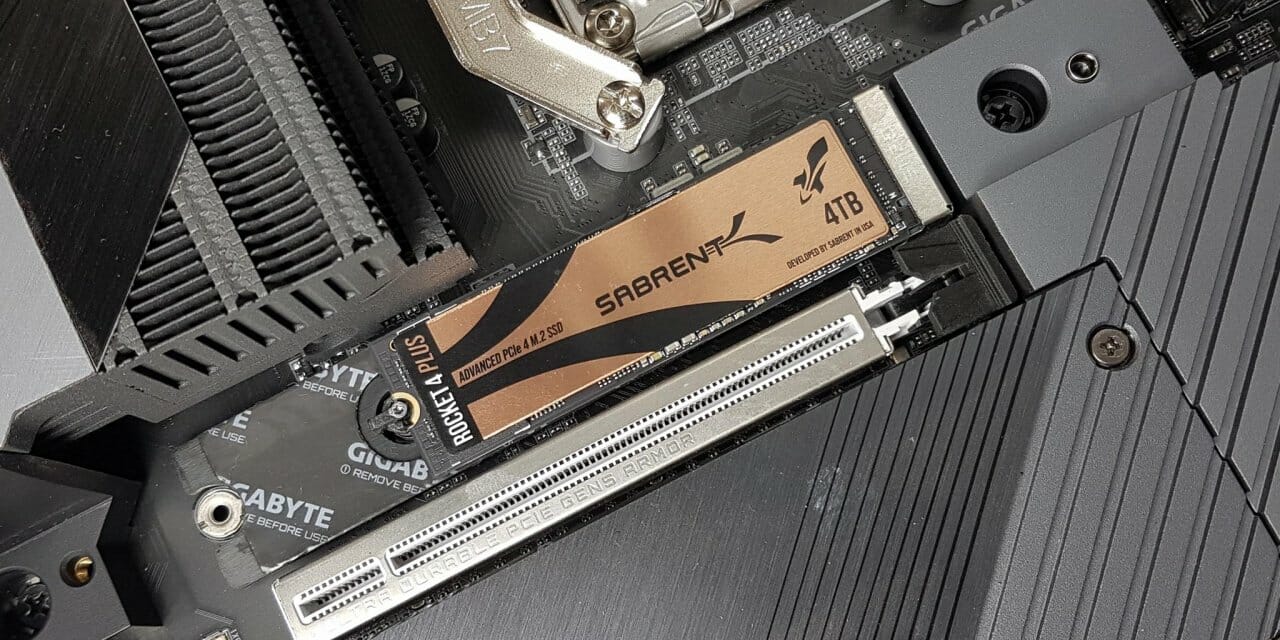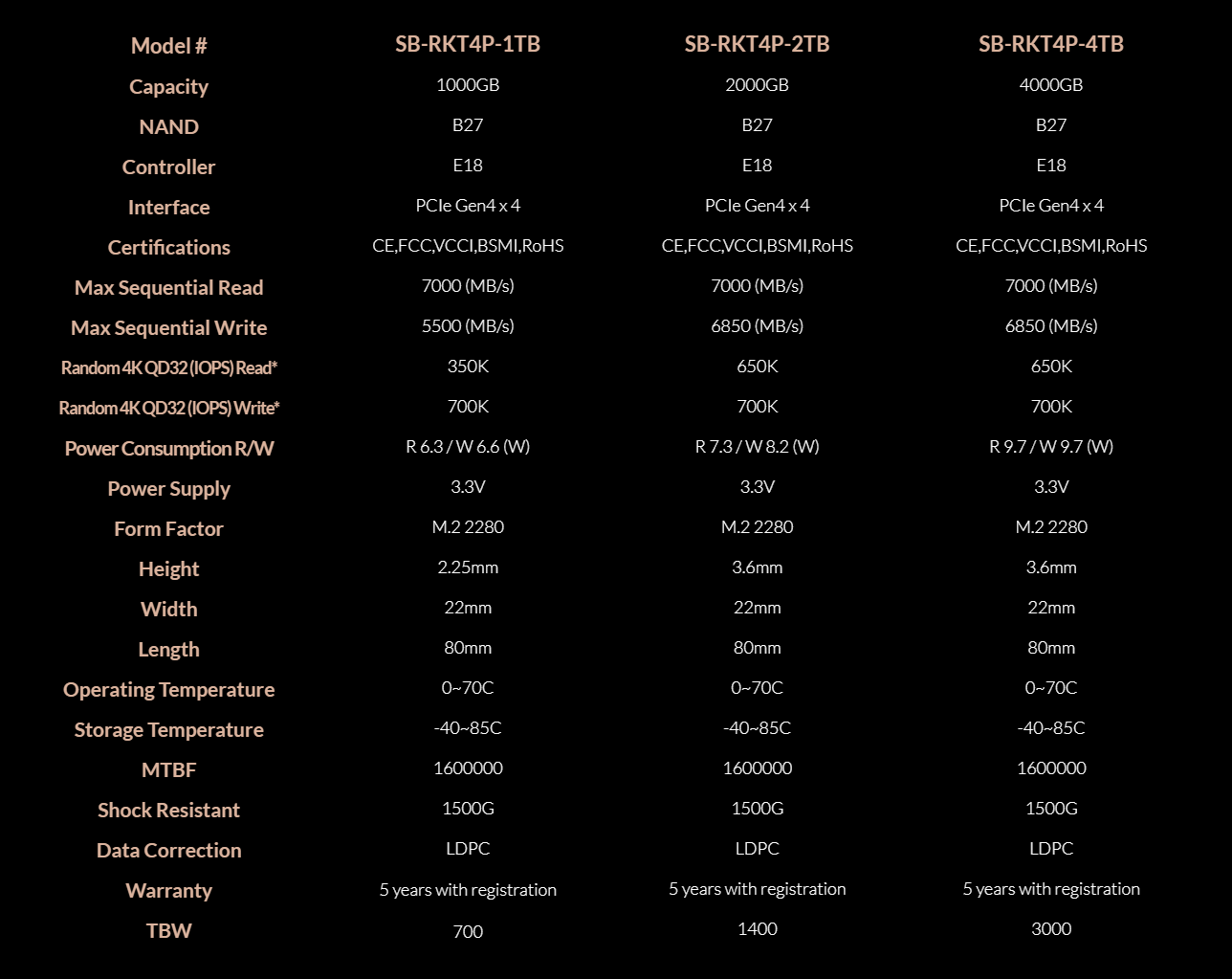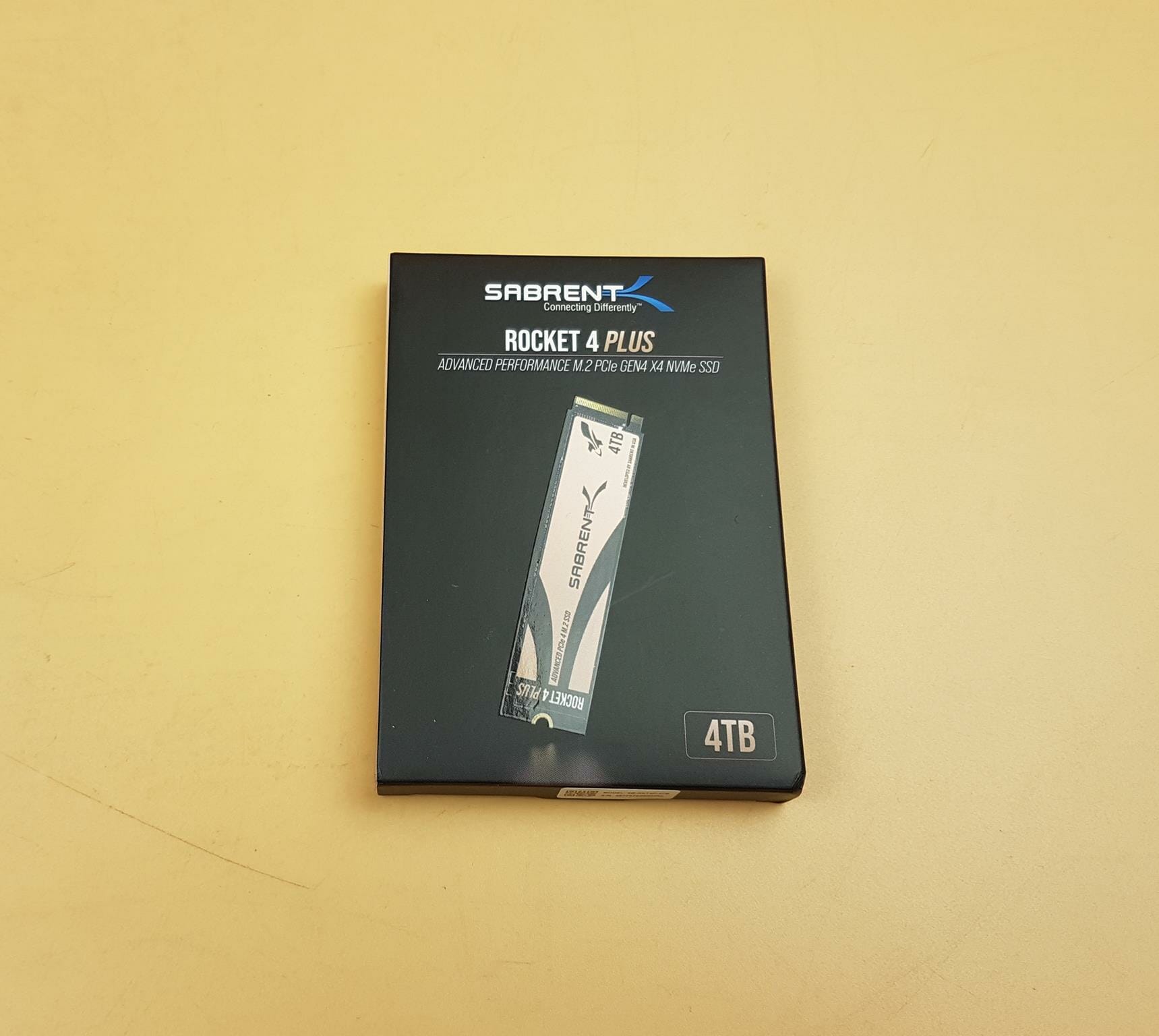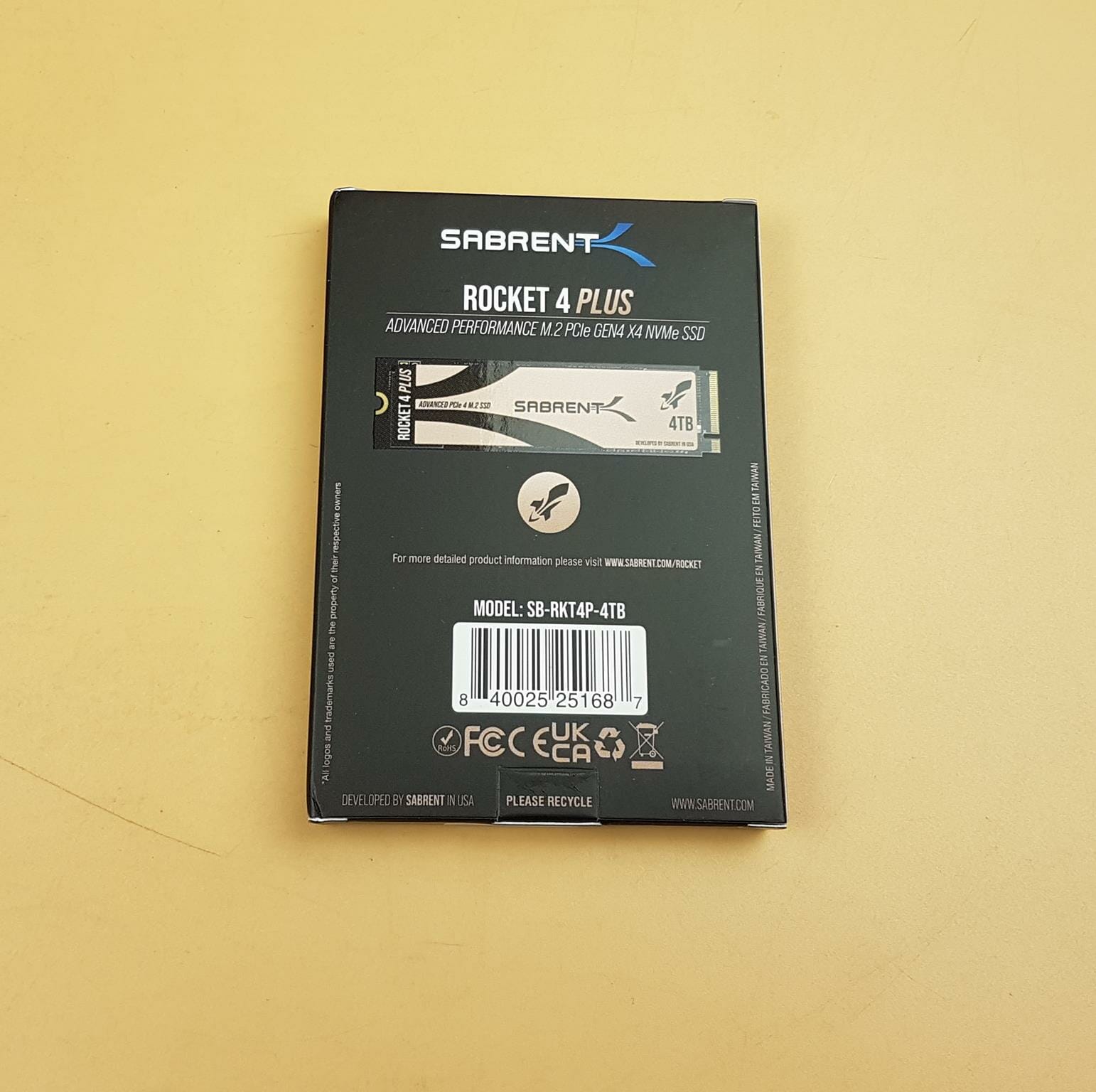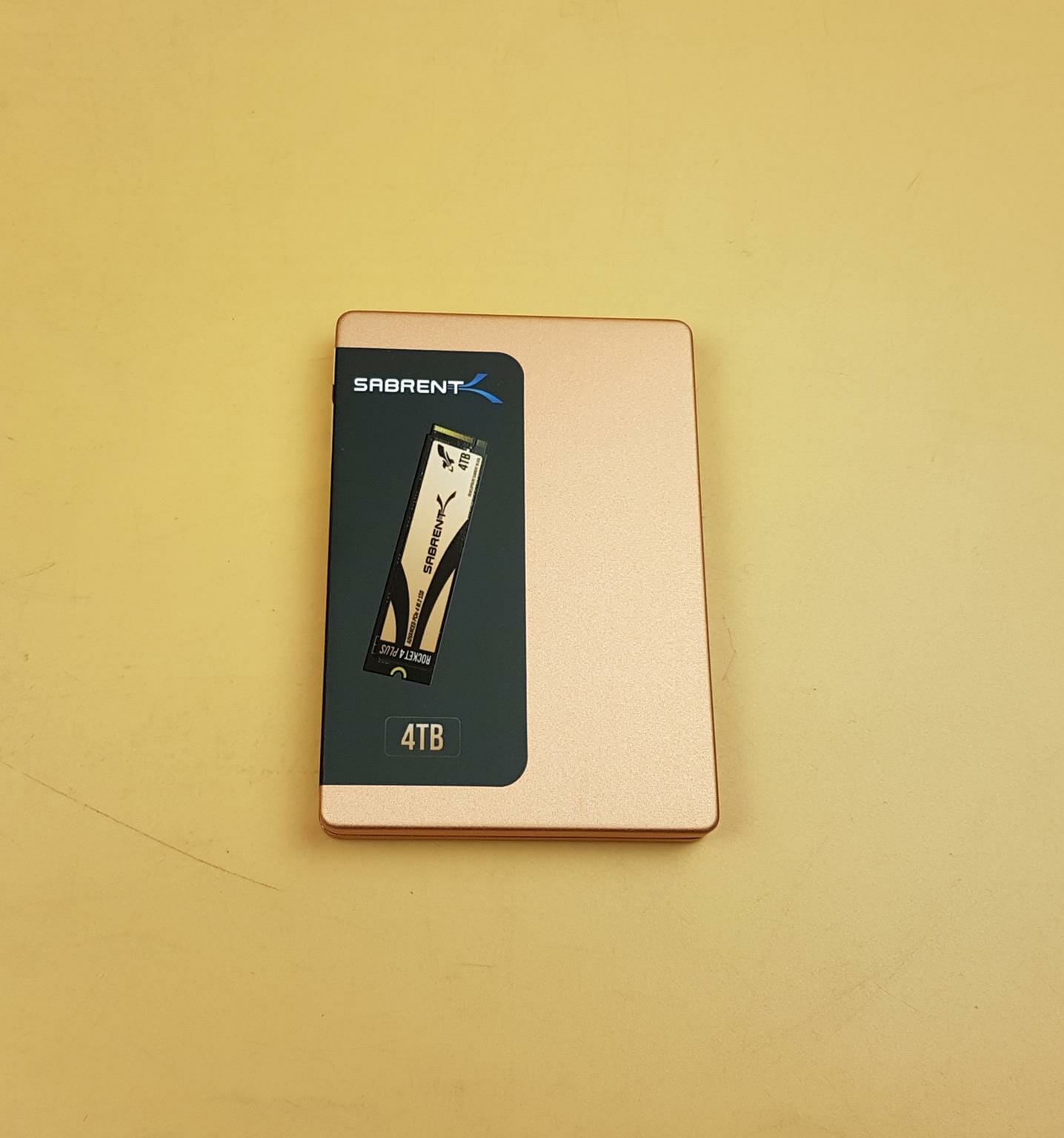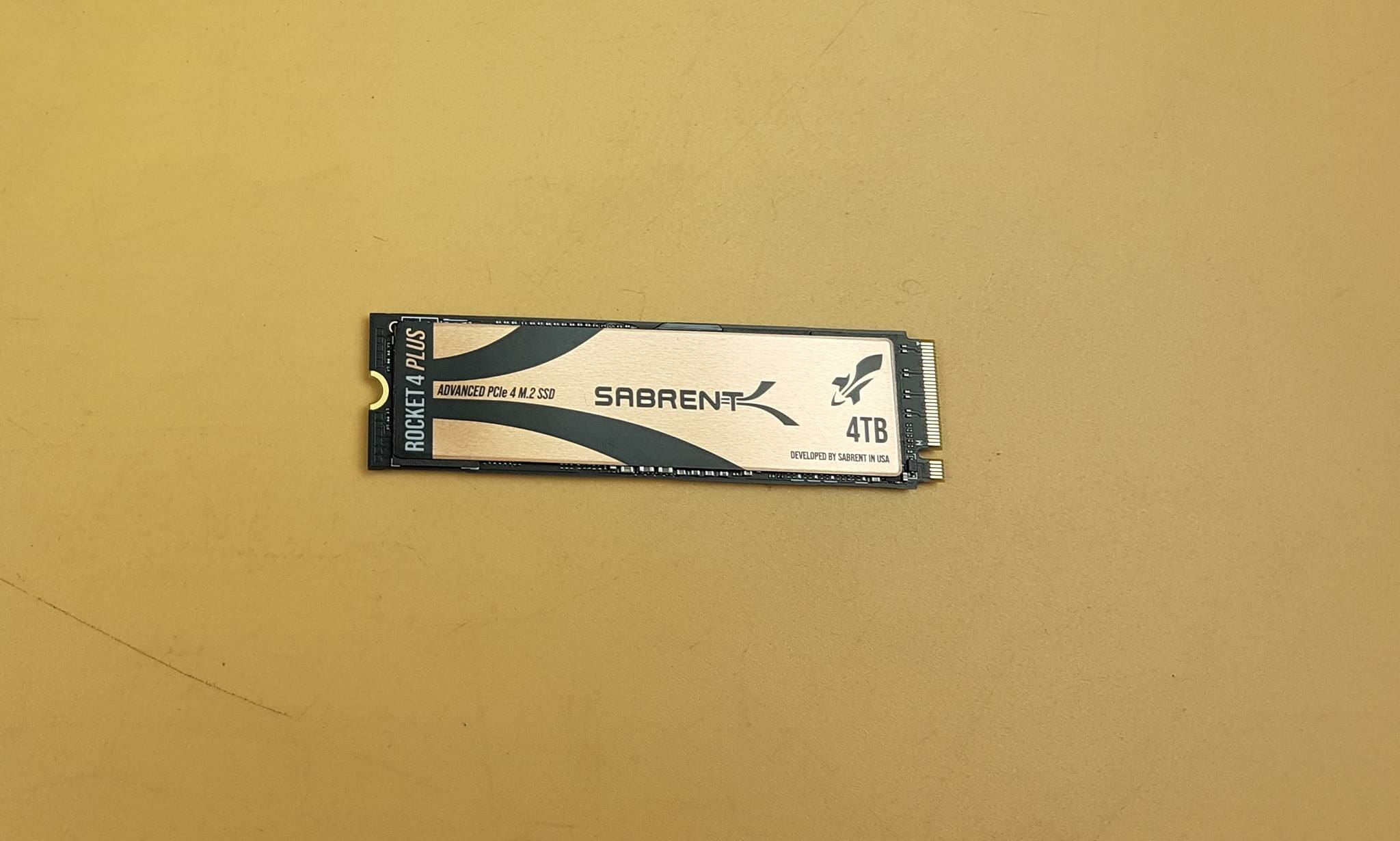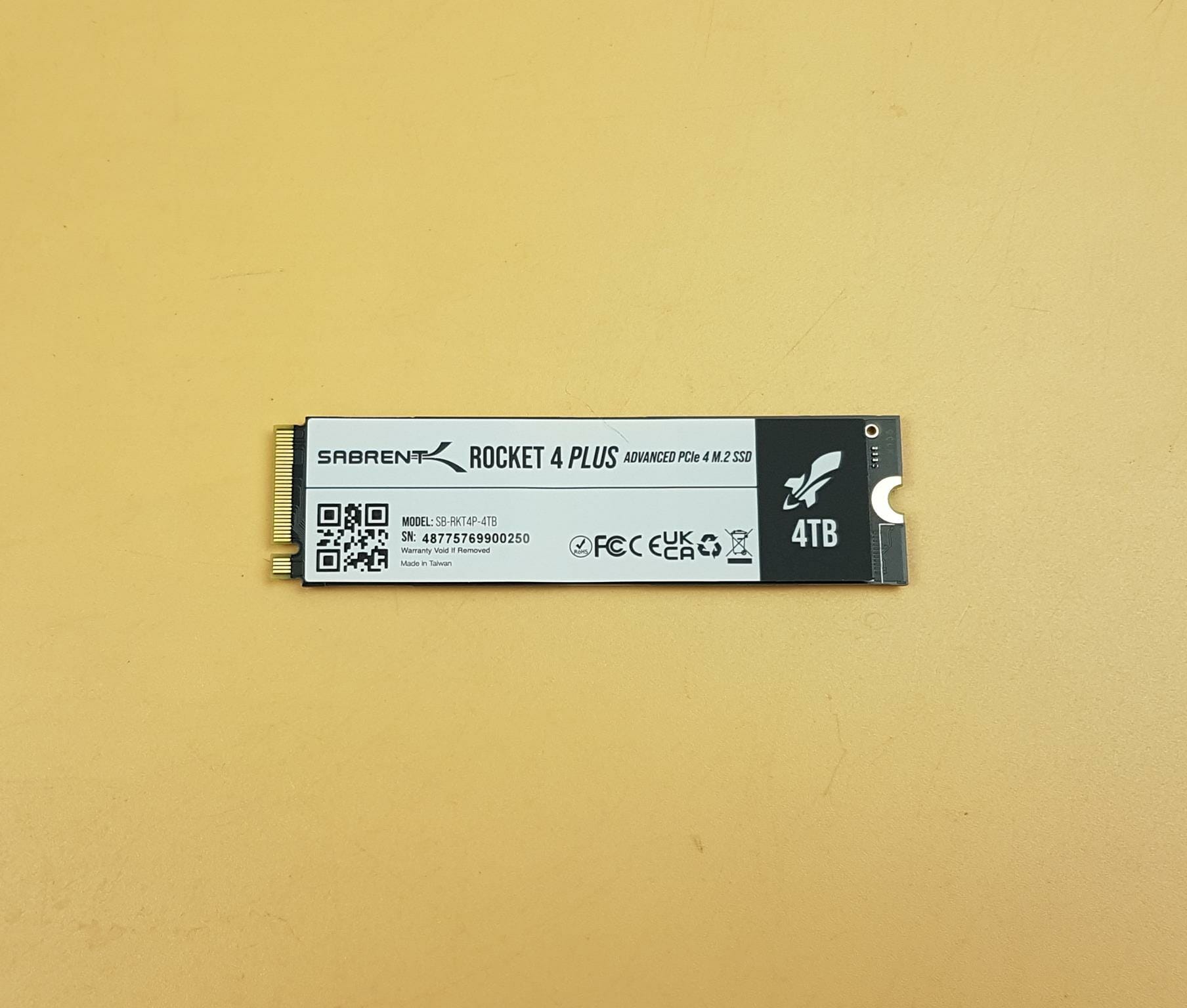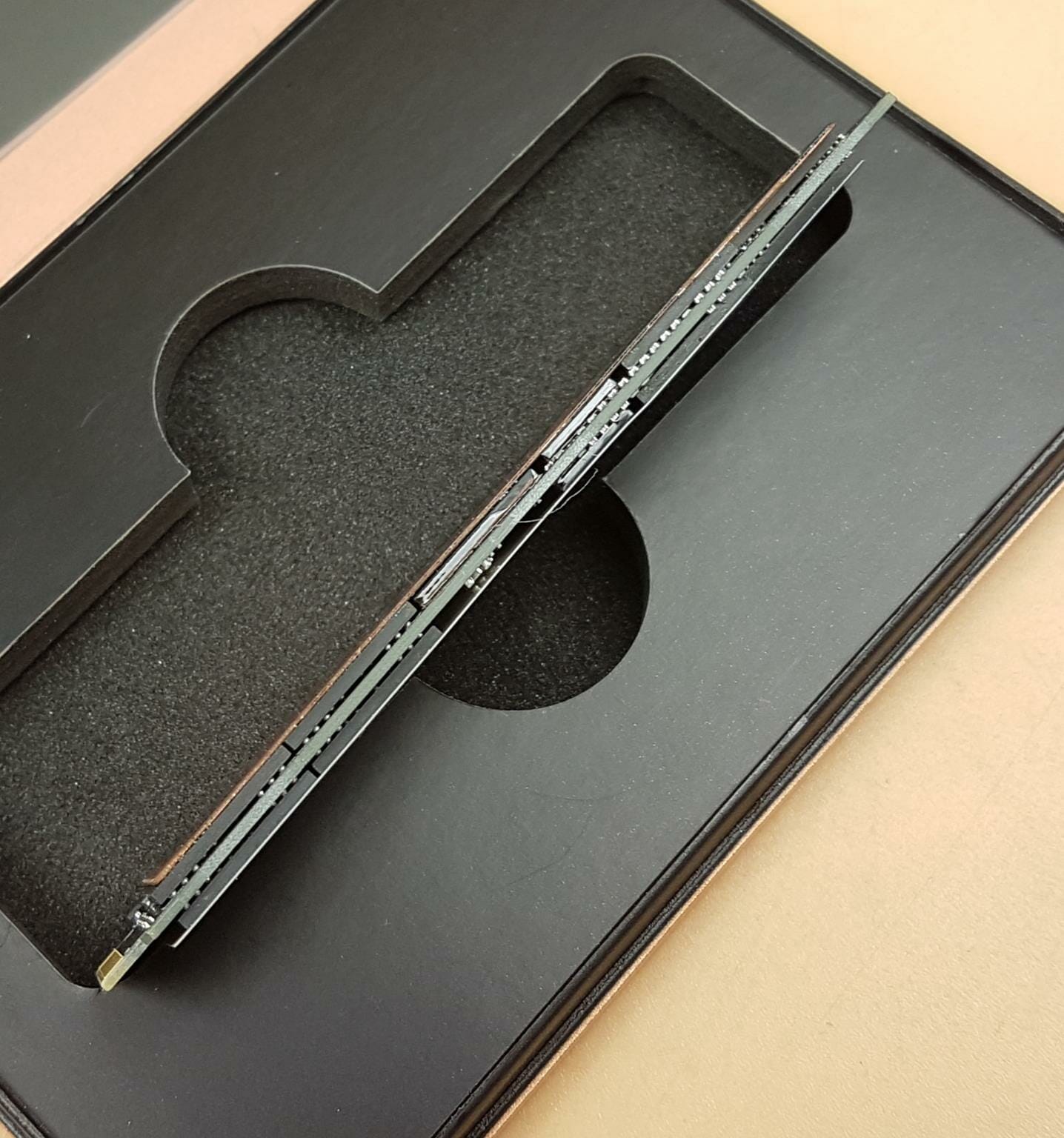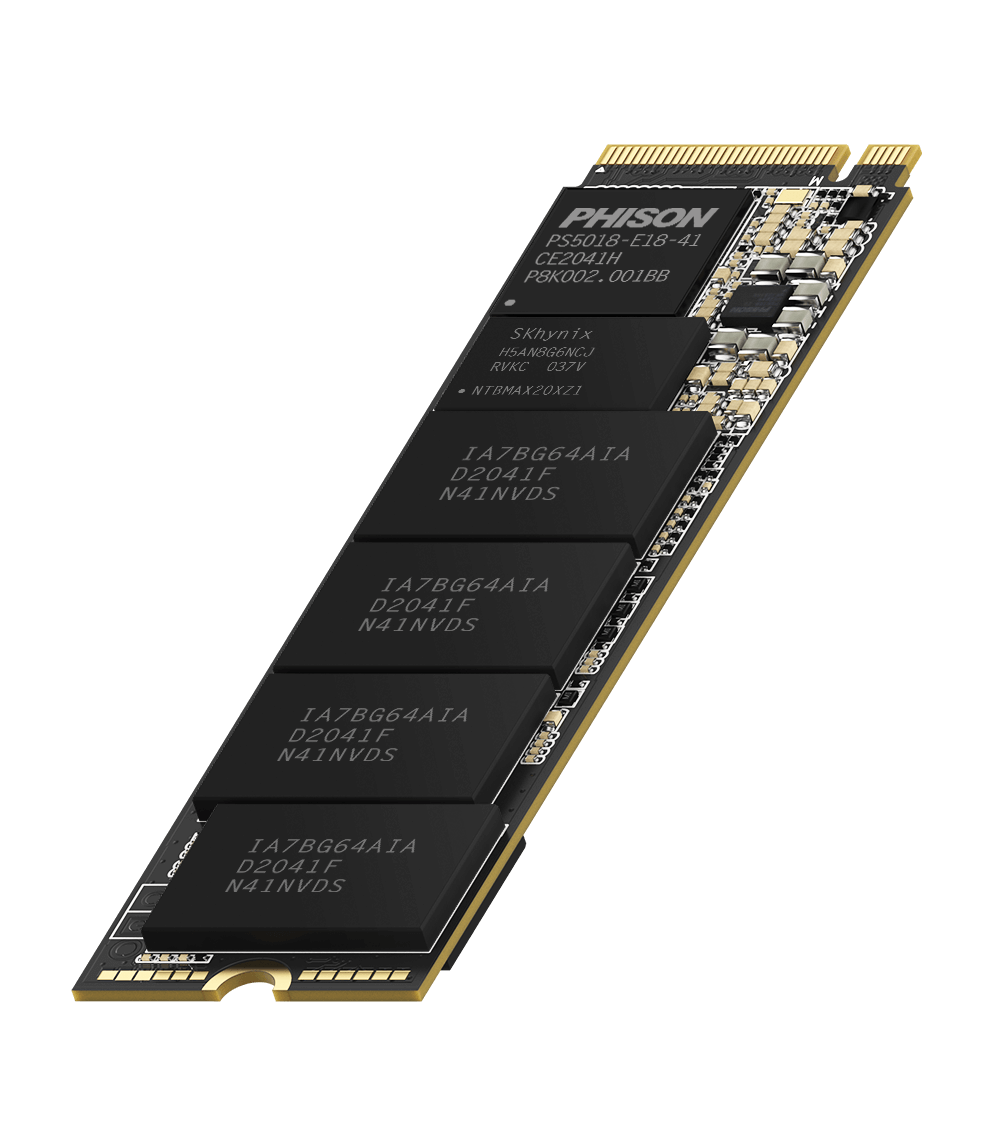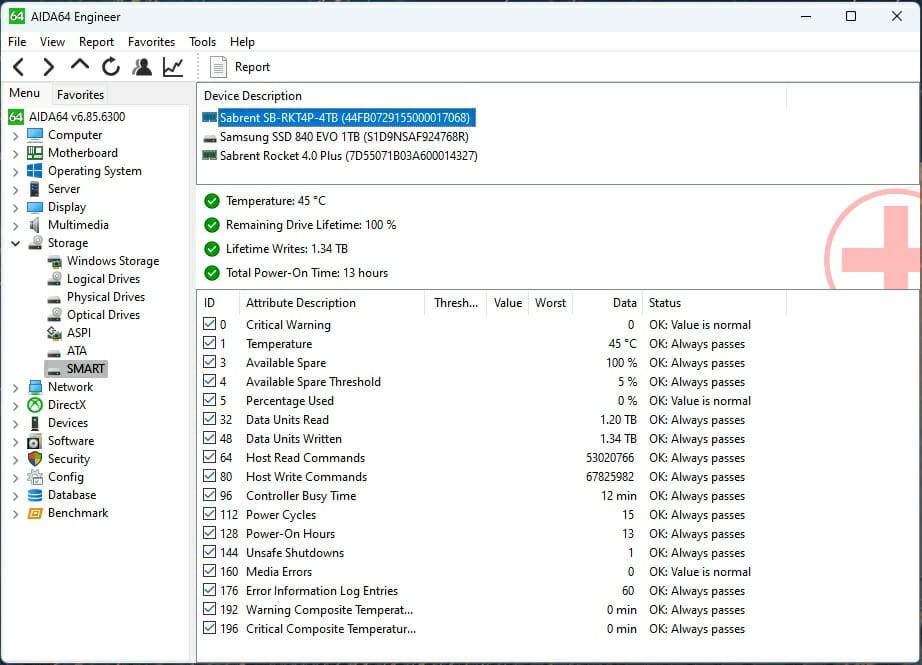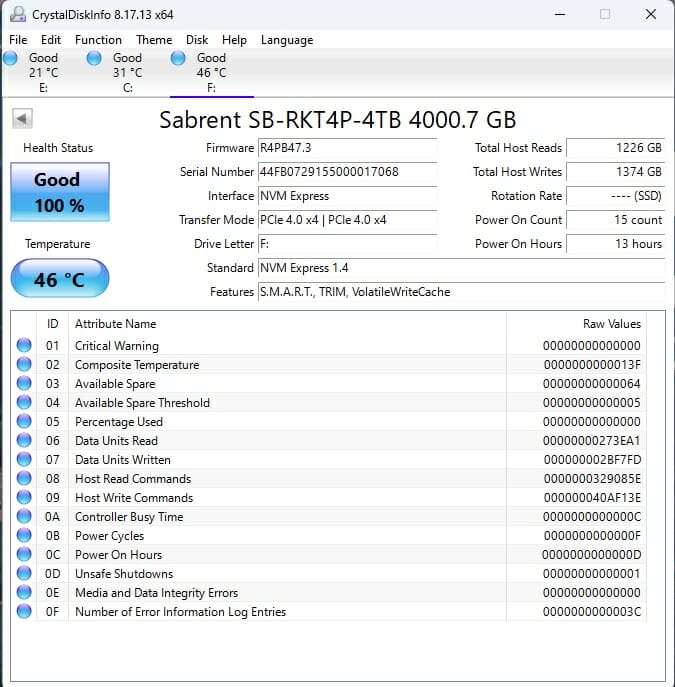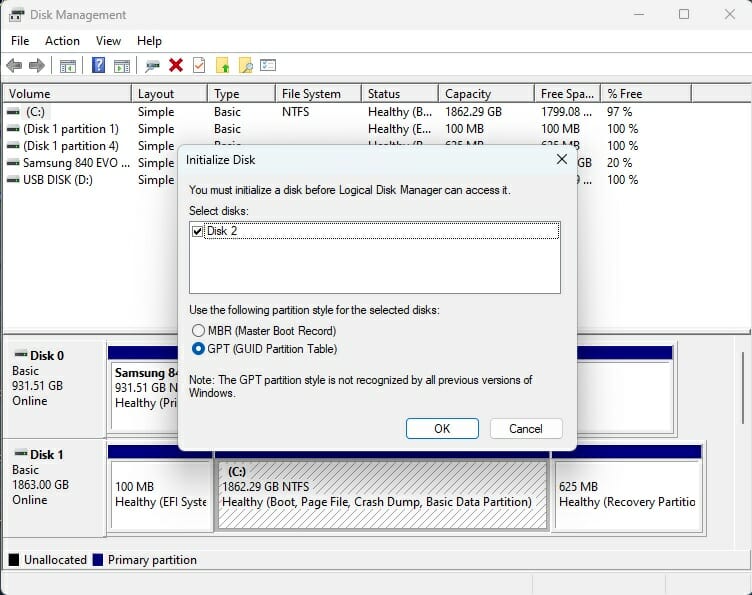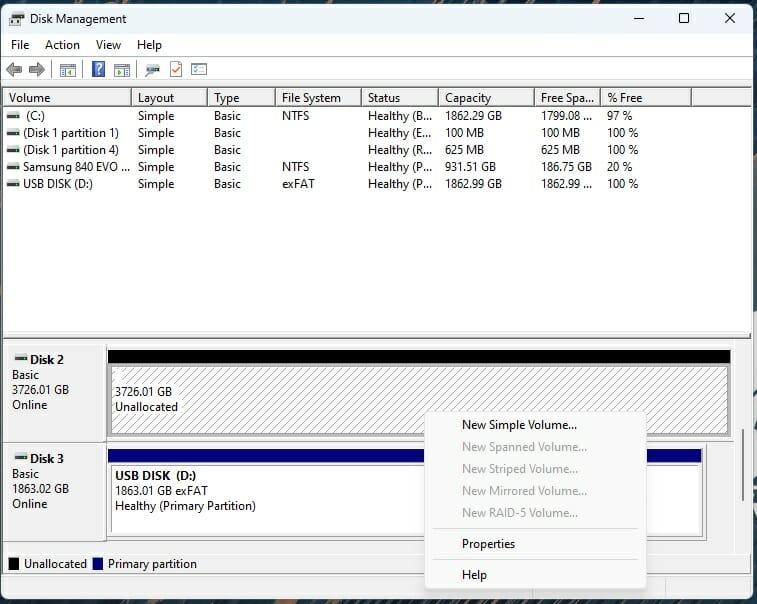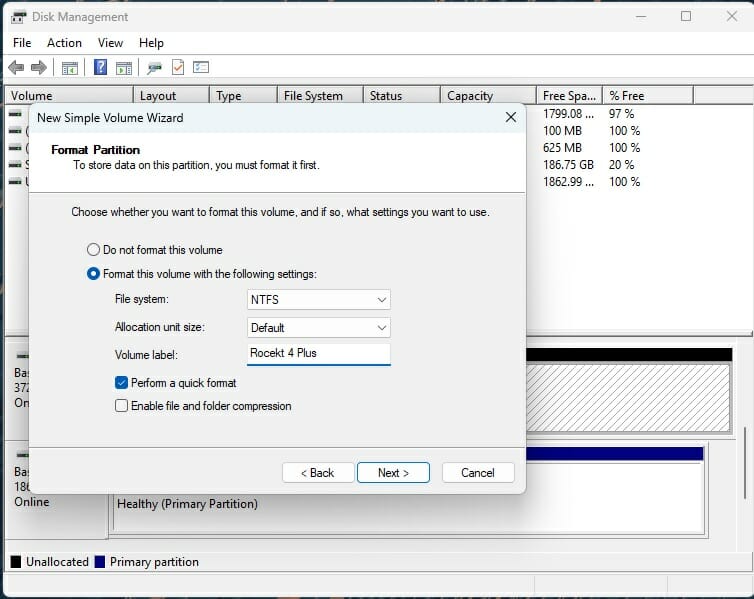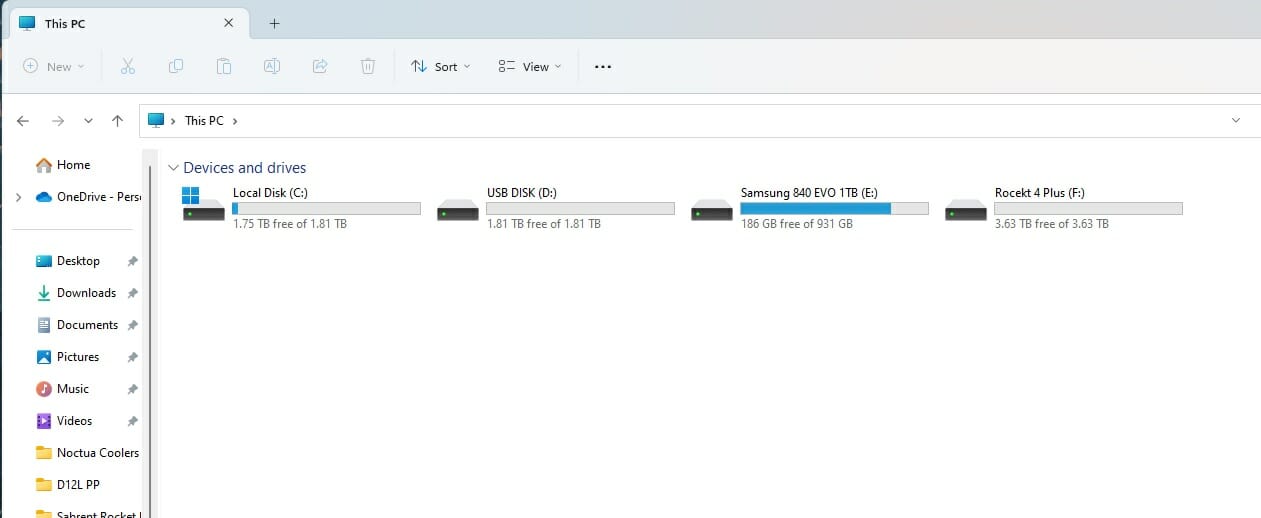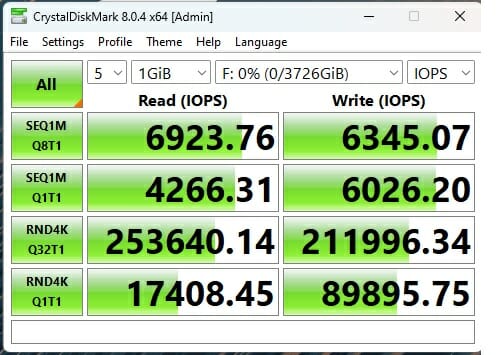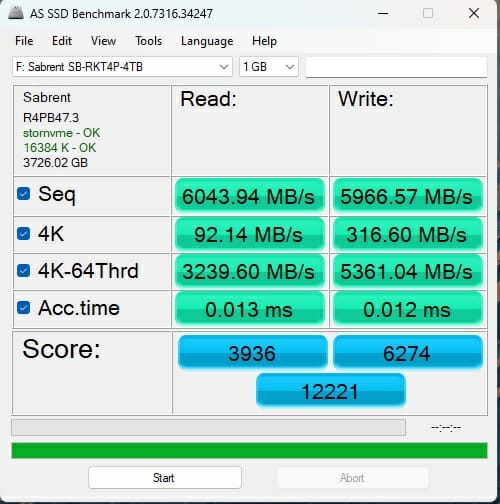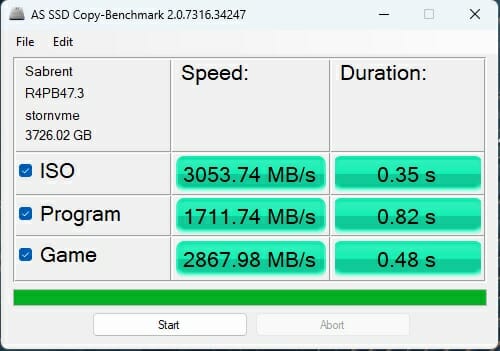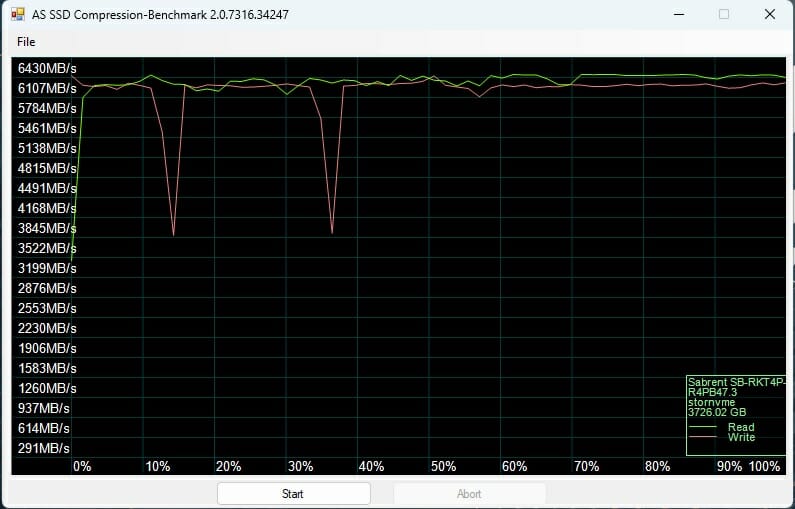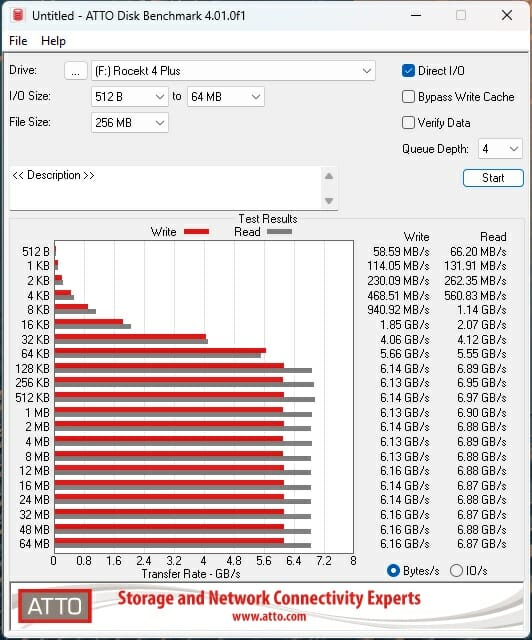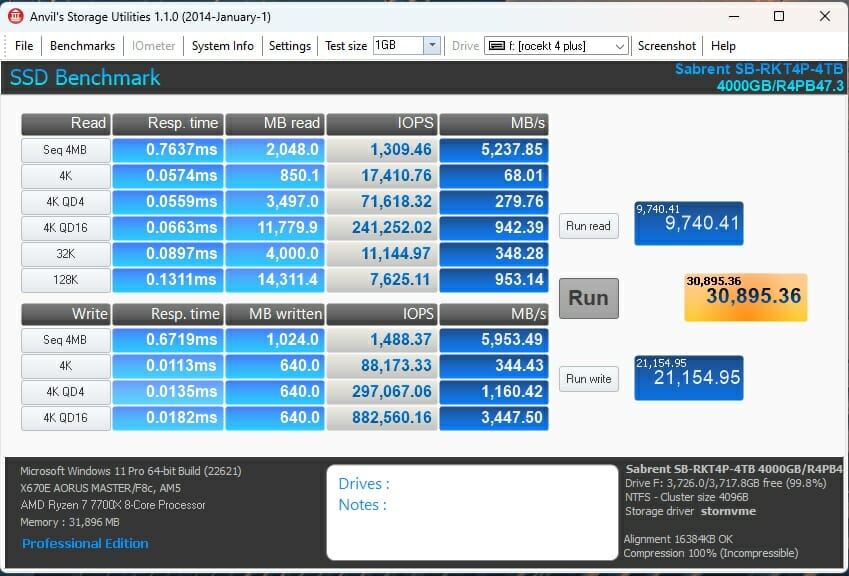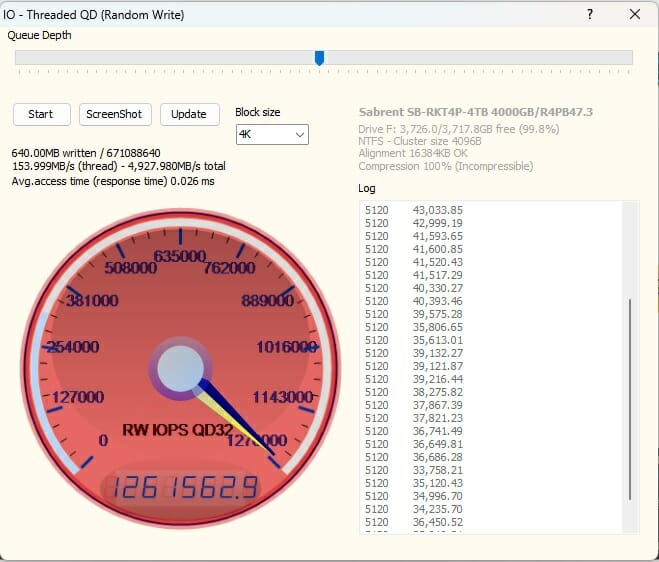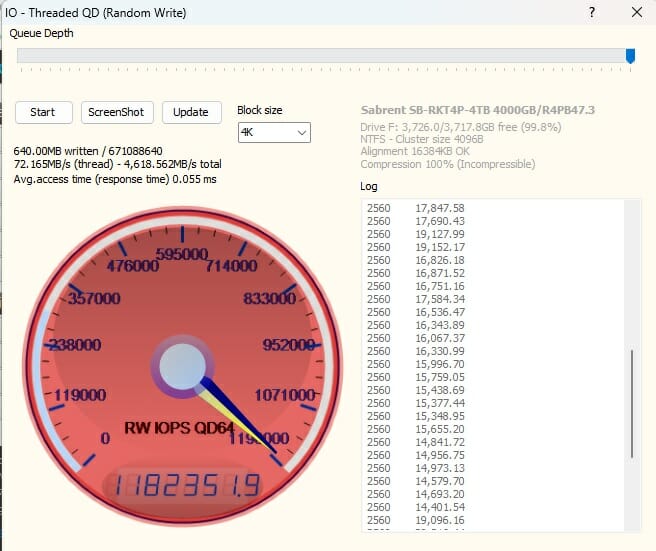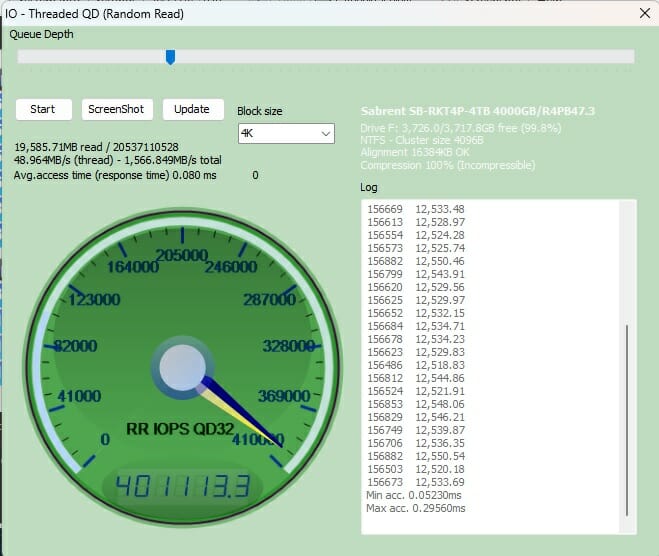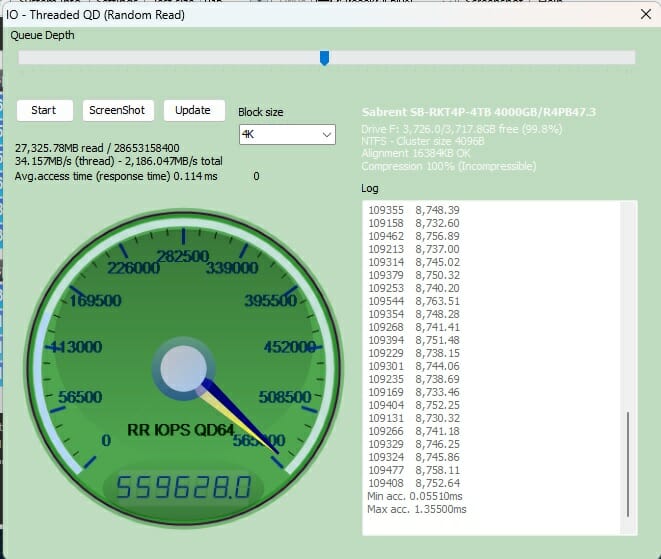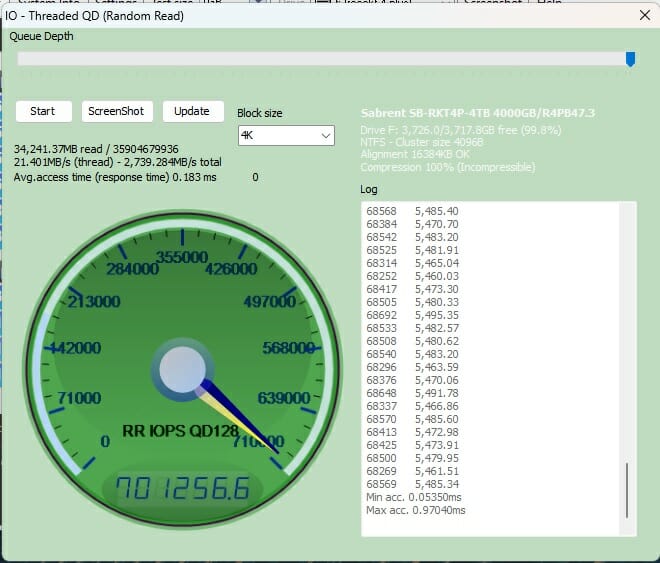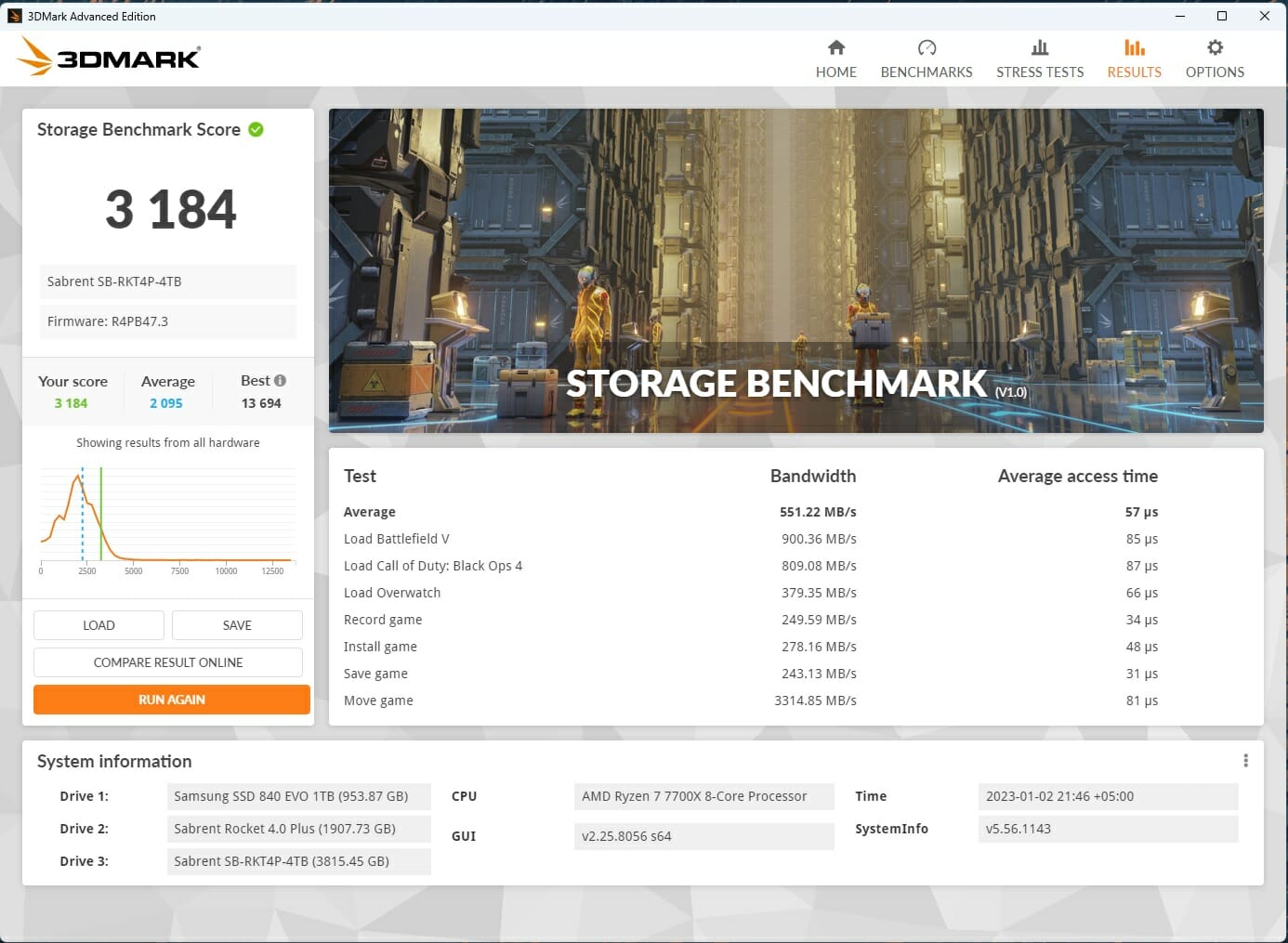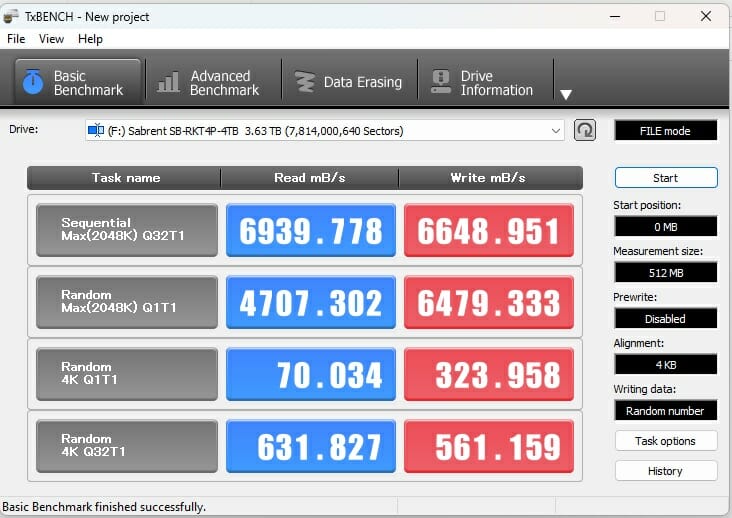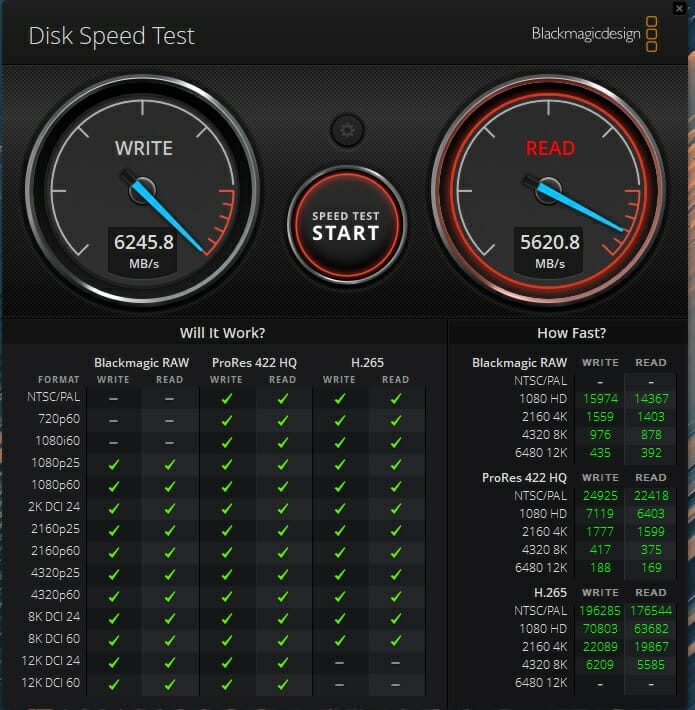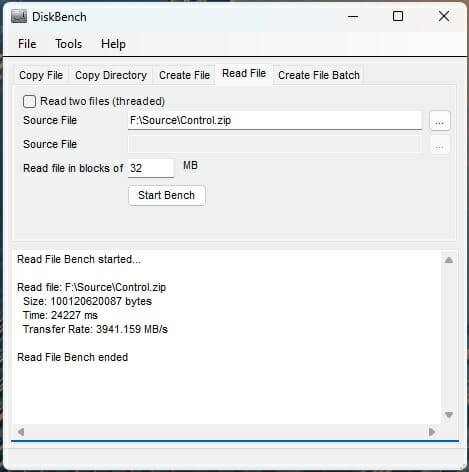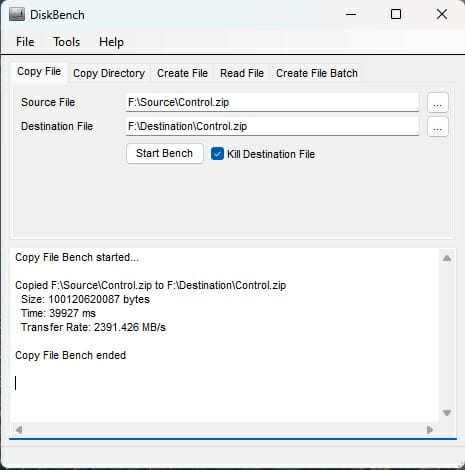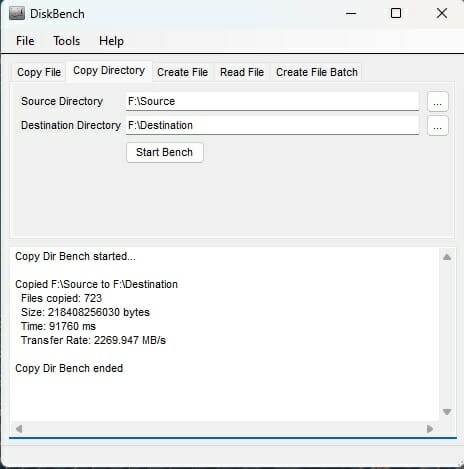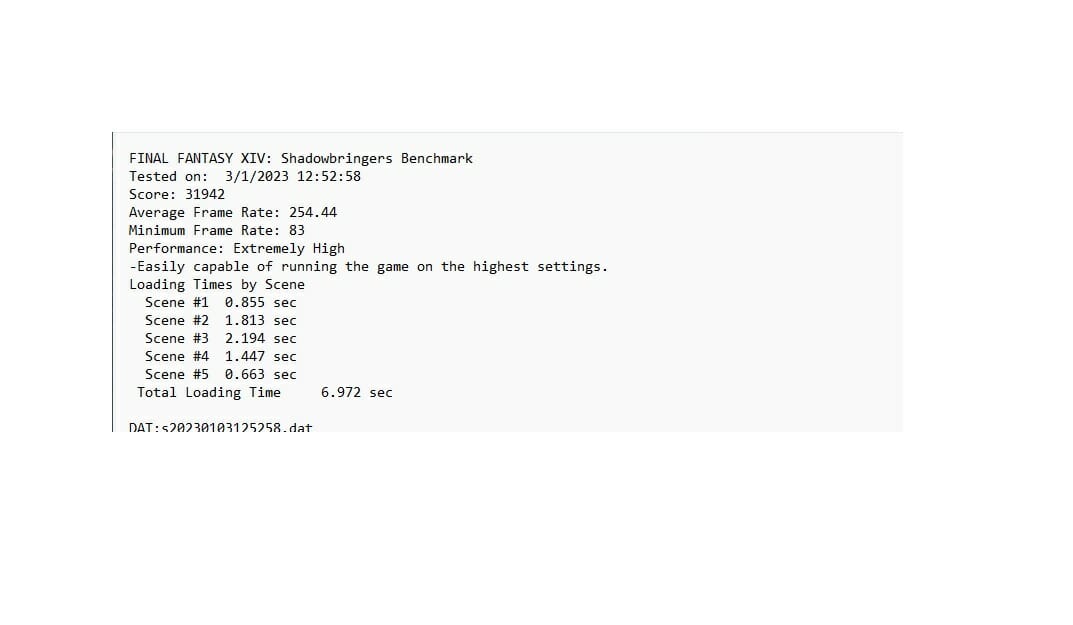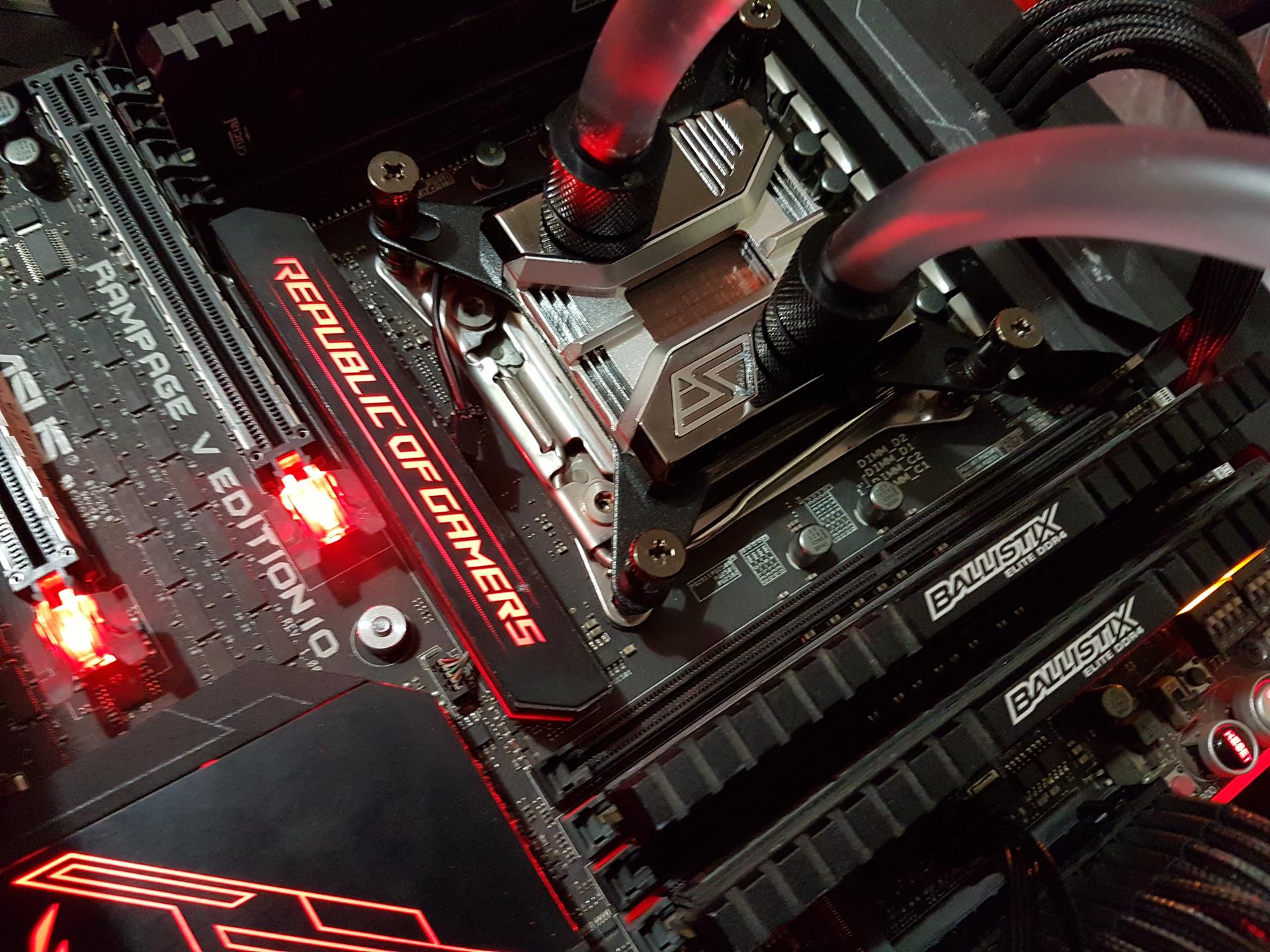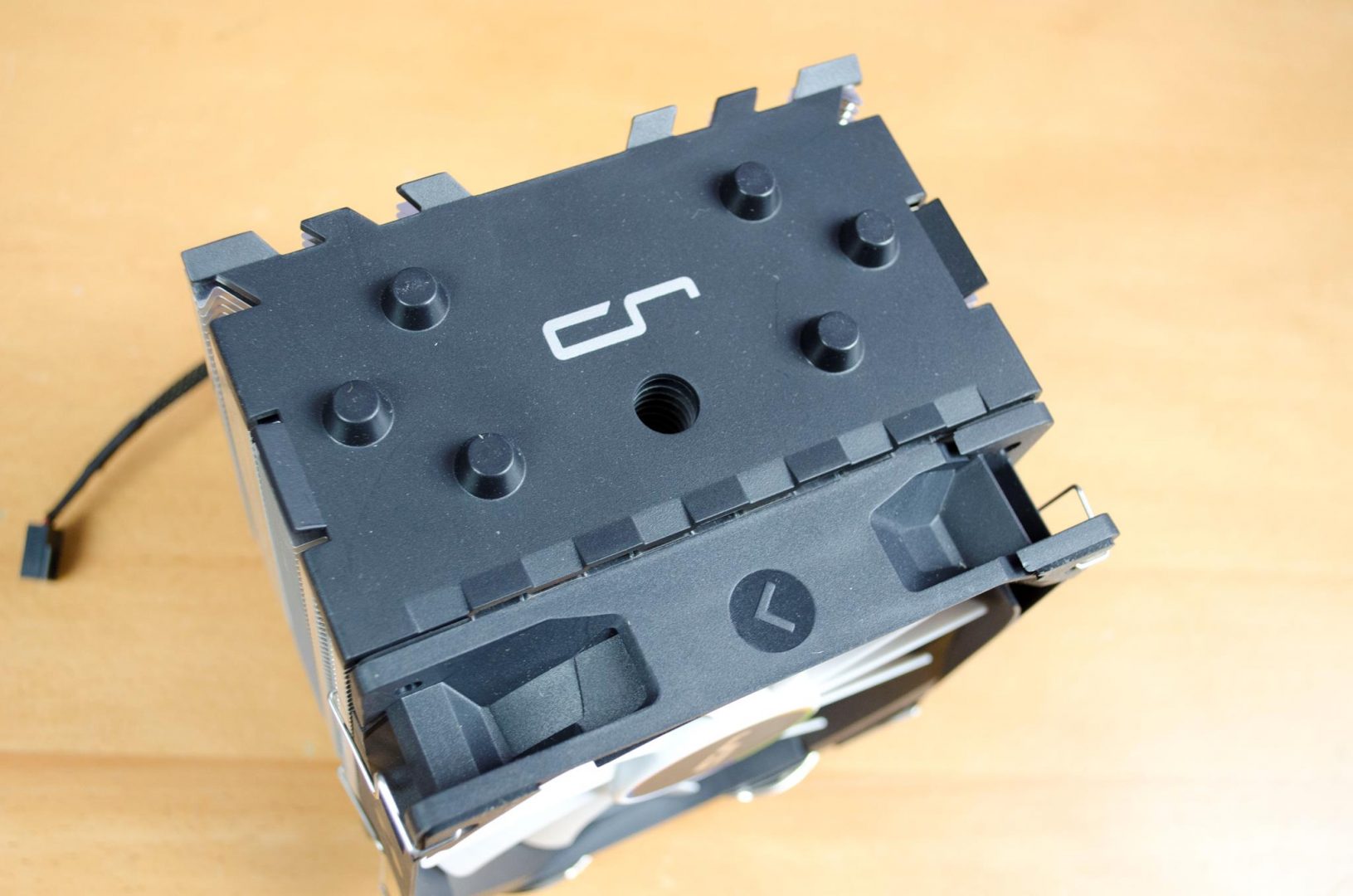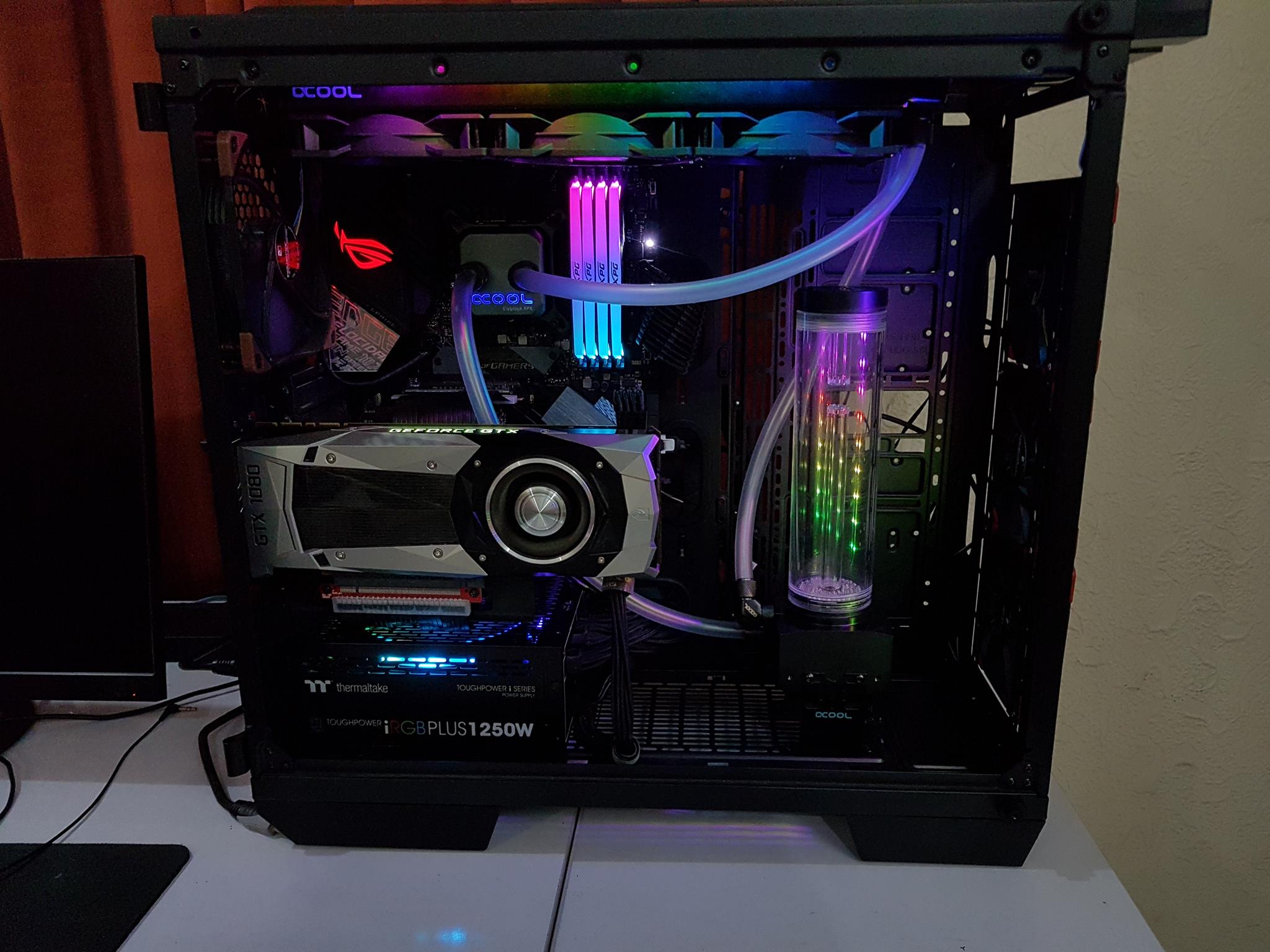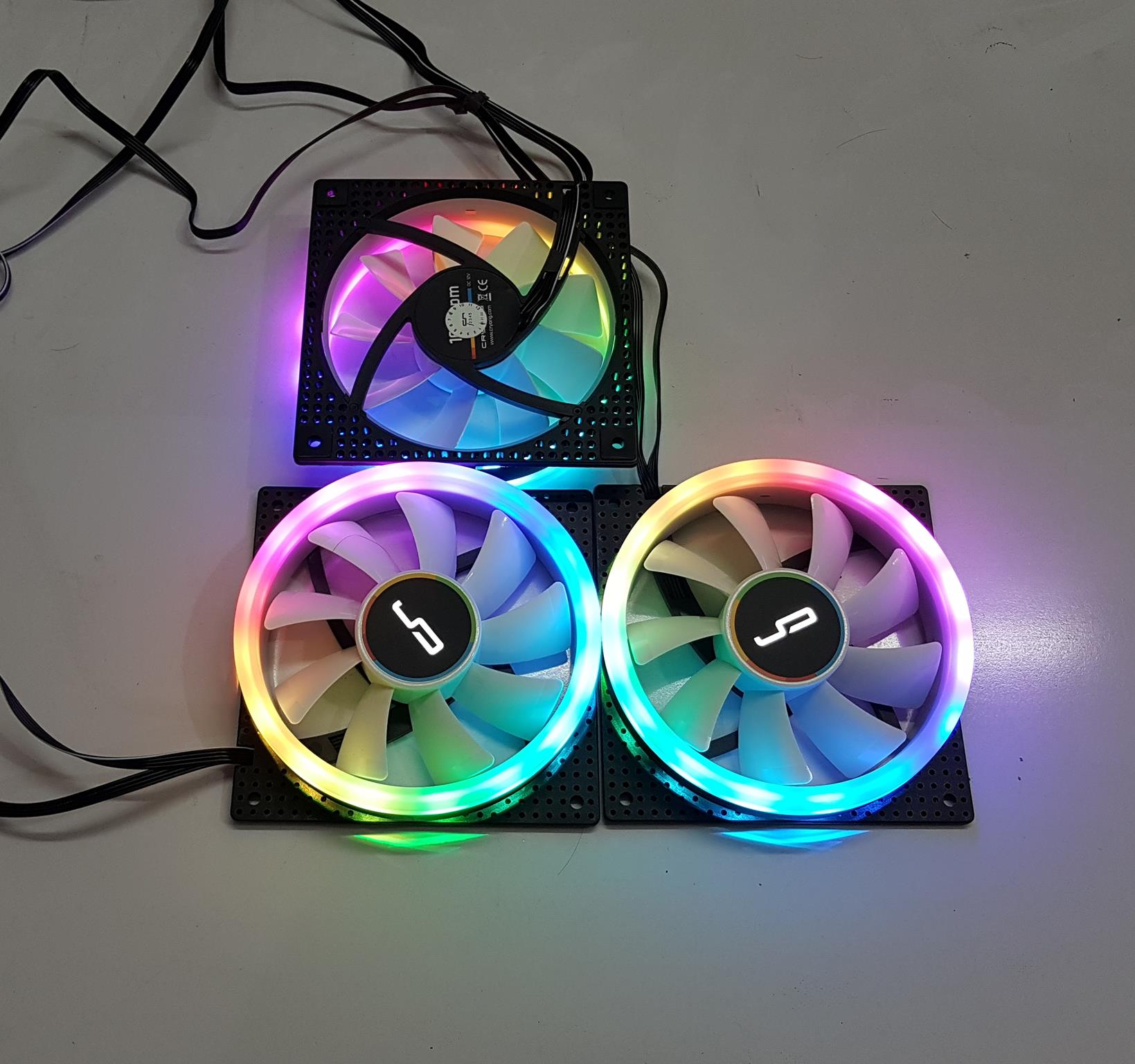Introduction
We earlier tested Sabrent Rocket 4 Plus 2TB NVMe SSD and found its performance top-notch. This time we are taking a look at Sabrent Rocket 4 Plus 4TB NVMe SSD. This is essentially the same drive but with double capacity. This SSD is based on PCIe Gen 4 utilizing the 4 lanes. The drive is rated for up to 7100MB/s sequential reads and up to 6600MB/s sequential writes on Gen 4 M.2 port. It is backward compatible with the PCIe Gen 3 but with reduced speeds which is obvious. We can expect a sequential read speed of up to 3400MB/s and 3000MB/s sequential write speed on PCIe 3×4.
Salient features include:
- PCIe 4.0 x4 interface, NVMe 1.3 compliant. APST/ASPM/L1.2 support.
- Supports SMART and TRIM functions. Works in an enclosure.
- Wide flash compatibility. Uses TLC with DRAM.
- Advanced endurance features for a long drive lifespan.
- Upgradeable firmware and software support.
- 0-capable motherboard and M.2 heatsink are recommended, but the drive is backward compatible with PCIe 3.0 and 2.0 M.2 sockets.
Product: Sabrent Rocket 4 Plus 4TB [SB-RKT4P-4TB]
Price: $599.99 [At the time of the review] (£789.97 on Amazon UK at the time of review)
Specifications
Packaging and Unboxing
The drive is shipped inside a paperboard-based packing box which is finished in a copper color theme.
This drive is using TLC NAND Flash chips and has a 4TB capacity. This is a high-performance NVMe SSD aimed at professionals, enthusiasts, gamers, etc.
The exact model is SB-RKT4P-4TB. Pay attention to the model number, particularly for the Rocket Plus series SSDs.
There is a hard closure inside the main packing box. It has a sticker label on both sides.
The above picture shows the opposite side of the hard closure.
We are seeing the same presentation that was on the 2TB variant. Opening the closure would show the user guide and the SSD along with the SSD cover.
Closer Look
The Rocket 4 Plus is a different breed as compared to the Rocket Q. While the Rocket Q reaps the benefits of the QLC enabling the series to reach speed up to 8TB and aims at budget users at best, the Rocket 4 Plus is aimed for the enthusiasts and professionals who would want nothing but the best. This series is using 3D TLC NAND Flash. The maximum capacity available in this series is 8TB. Obviously, cost considerations are there. TLC stores 3 bits per cell as compared to the other NAND flash.
The Sabrent Rocket 4 Plus NVMe PCIe 4×4 4TB SSD has an M.2 form factor of 2280. It is an M Key type SSD compatible with the majority of the M.2 slots on modern motherboards. It is also backward compatible with the PCIe Gen 3 but with reduced speeds.
The dimension of the SSD is 80x22x3.65 (LxWxH) and it has a weight of 2.4Oz. The Sabrent Rocket 4 Plus series SSDs don’t need a dedicated driver on Microsoft Windows 8.1 and 10. Since these SSDs are using the operating system’s native NVMe driver, there is no dedicated software either by the manufacturer. There is a zinc color thin layer of copper cover on the SSD. This acts like a heat transfer element on the SSD. The drive in consideration has 4TB capacity and is PCIe Gen4 based using 4 PCIe lanes for connectivity.
The operating temperature of these drives is 0°C to 70°C whereas the storage temperature requirement is -40°C to 85°C. These have a shock resistance of 1500G. The MTBF is mentioned to be 1,600,000 hours. The SSD comes with a 2-year warranty which can be made for 5 years but only with the registration. The TBW (Terrabytes Written) value is mentioned to be 3000 TB meaning we roughly get a guaranteed of 600 TB per year in 5 years warranty which is quite impressive. This SSD is rated for up to 7100 MB/s sequential read speed and up to 6600 MB/s sequential write speed when connected to PCIe Gen 4-enabled port. Coming to 4K stats, this SSD is rated for up to 650K IOPS in Random 4K Read and 750K IOPS in Random 4K Writes. These numbers are provided based on a Queue Depth of 32.
There is a white color large size sticker on the back. It has the part number and a serial number of the drive printed. The drive is rated to draw 9.7W for read operations and 9.7W for write operations. The power supply is rated at 3.3V.
The Rocket 4 Plus NVMe PCIe 4TB is a dual-sided SSD meaning the components are on both sides of the PCB. When we say components, we mean the controller, DRAM, NAND Flash, and the circuitry.
Speaking of the components, the Rocket 4 Plus 4TB NVMe PCIe SSD is powered by the power horse Phison E18 controller. This controller can be found in the majority of high-range SSDs. This controller is based on TSMC 12nm process technology using a 32bit ARM Cortex R5 micro-controller in Triple-CPU architecture with up to 8 channel support. The controller has support for Dynamic SLC Cache and supports 1600MT per channel in DDR4 DRAM. This SSD packs 8x 3D TLC NAND chips from Micron. Each chip has a 500GB capacity. We have a DDR4 SDRAM 8Gbit 512M X 16 1.2V 96-Pin FBGA from SKHynix. The H5AN8G6NCJR is an 8Gb CMOS Double Data Rate IV (DDR4) Synchronous DRAM, which is suited for the main memory applications requiring high density and high bandwidth.
The above picture shows the ADIA64 Extreme’s S.M.A.R.T status of the Rocket 4 Plus 4TB NVMe PCIe SSD.
The above picture shows Disk Info from CrystalDiskInfo.
Testing
The following configuration is used for tests:
- AMD Ryzen 7 7700X [Stock, Auto]
- GIGABYTE X670E AORUS MASTER
- XPG Lancer RGB 32GB @ 6000MHZ CL40 DDR5
- EK-AIO Elite 360 D-RGB cooler
- Sabrent Rocket 4 Plus 2TB NVMe SSD [OS Drive]
- MSI GeForce RTX 3090 Gaming X Trio 24G
- be quiet! Straight Power 11 850W Platinum PSU
We have used the following software:
- AS SSD 1.8.5636.37293
- ATTO Disk Benchmark 4.0
- CrystalDiskMark 6
- Anvil Pro Storage Utilities 1.1.0
- TxBench
- Blackmagic Disk Test bench
- 3DMark Storage
- DiskBench
Since this is the first SSD being tested on this platform, we are showing the snapshots of the respective software run. Microsoft Windows 11 22H2 is used.
Once in the Windows environment, the disk needs to be initialized first. Access the Disk Management service. It will immediately recognize the drive and gives the user to format the drive either in MBR or GPT partition style. Click on the desired style and Click on the OK button.
We now have a Basic Disk. Right-click on it and select New Simple Volume to start allocating the unused space under the volume.
Format the drive as per the user’s required setting.
Now, the drive is ready.
Test Results
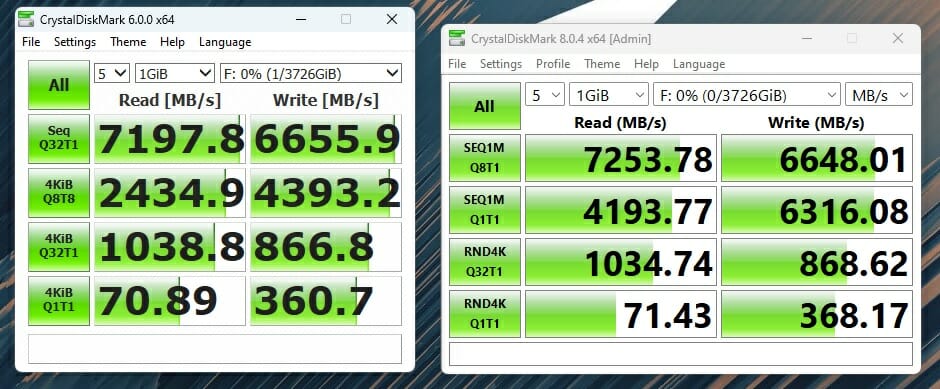
We have superb performance on the sequential read and write speeds from the Rocket 4 Plus 4TB NVMe SSD. We have good results in the 4K Q32 section as well.
Next, we run the AS SSD software to test the performance of the drive. Please, note that each stress testing software works differently and there would be variations between software and between two runs even on the same SSD. We have an overall score of 12221 from this test run which is an impressive score.
The above is a result of the AS-SSD Copy benchmark. It shows the speed and duration of different workloads giving an idea of the real-world use scenario. Scores are self-explanatory.
The above pictures show the result of the Compression benchmark run from AS-SSD. Ideally, we would not want dips across the length of the line for both read and write operations. We are seeing a good result from the read operation but we observed two deep dips in the write operations.
Next, we ran the ATTO Disk Benchmark to test the drive’s performance. We have a maximum read (sequential) speed of 6.87 GB/s which is quite impressive. The average is above 6.16 GB/s as well on the reads.
Next, we ran the Anvil Storage Utilities benchmark to test the performance of the drive. On the default test size of 1GB, the tested read speed score was 9740.41. The write speed score was 21154.95 with an overall score of 30895.36.
Next, we ran the IO – Threaded QD Benchmark in the Anvil. Here are the results.
We have a speed of 1261562.9 with QD32 in the write operations.
We got 1182351.9 speed with a QD64 in the write operations.
Next, we ran IO – Threaded operations for the read speed using different queue depths. Here are the results
We have 401113.3 IOPS.
When the queue depth was raised to 64, the speed was 5596280 IOPS.
With a queue depth of 128, the read speed was 701256.6.
3DMark Storage Test
3DMark Storage test is relatively a new test bench measuring the gaming-only performance of the given drive using three games. It measures the load time of the games, recording the gameplay, saving the game, and moving the game. The overall score is given in the bandwidth and access time.
The Sabrent Rocket 4 Plus 2TB SSD did an average of 551.22MB/s and 57µs.
TxBench
We have an overall good score.
Black Magic
We are seeing a dip in the Read speed in this bench.
Real World Testing
We have used DiskBench in multiple scenarios to check the real-world data transfer rates. Here are the results:
A compressed file of 97GB containing multiple compressed files and folders of different sizes was copied to the Rocket 4 Plus 4TB SSD. The file was then read from the DiskBench. We have a transfer rate of 3941.159 MB/s with a time of 24.227 seconds.
Next, we copied the same compressed file from one folder to another on the same drive. The transfer rate is 2391.426MB/s with a time of 39.927 seconds.
Next, we copied a folder of 210GB size containing multiple compressed files, sub-folders, and mixed other files. The transfer rate was 2269.947MB/s with a time of 1 minute and 31.76 seconds.
The real-world transfer rates are quite impressive. Remember we are paying a premium price for this level of performance.
Gaming Load Time
Since these NVMe SSDs are also targeted toward gamers alike. We have also calculated the loading time of the game using the Final Fantasy XIV: Shadowbringers Benchmark using High settings.
Impressive load time using the RTX 3090.
Thermals
We saw a maximum temperature of 56°C at an ambient temperature of 14°C on the Rocket 4 Plus 4TB NVMe SSD. The SSD was idling at 17°C. Seems like the thermal pads and the heatsink of the GIGABYTE X670E AORUS MASTER motherboard is doing a better job.
Conclusion
The Sabrent Rocket 4 Plus is an enthusiast-grade high-performance, super-fast storage solution from the manufacturer. This series SSDs are available in 1TB, 2TB, 4TB, and 8TB capacities. These SSDs are using 3D TLC NAND from Micron. These SSDs are reaping the full benefit of PCIe Gen 4 by utilizing 4x lanes. Hence you would need a PCIe Gen 4-enabled motherboard to take full benefit of these SSDs.
The Sabrent Rocket 4 Plus is M key type SSD using the 2280 form factor. The SSD has a sequential read speed rating of up to 71000MB/s and a sequential write speed of up to 6600 MB/s. These speeds can only be realized when on PCIe gen 4.0. These speeds would reduce to 3400MB/s and 3000MB/s read and write respectively on PCIe Gen 3.0. The 4K random read and write speed ratings are 650K and 700K IOPS respectively using QD32.
The main driving force in this SSD is a power horse from Phison in the form of an E18 controller. We have eight 3D TLC-based NAND flash chips from Micron and 8GB DDR4 DRAM from SK Hynix. This is a dual-sided layout where the components are on both sides. The top cover has a thin layer of copper for heat transfer. I would not remove it for anything.
The TBW rating is 3000. Sabrent is offering a 2-year warranty on this SSD. The user can register the SSD within 90 days of purchasing to get the 5-year warranty. The SSD is PCIe 4.0 compliant with NVMe 1.3 compliance. Power management support for APST/ASPM and L1.2 is provided. It supports the TRIM and SMART commands along with the ONFi 2.3, 3.0, 3.2, and 4.0 interfaces. It features Advanced Wear Leveling, Bad Block Management, Error Correction Code (Thanks to E18), and Over-Provision. The firmware of the SSD can be upgraded using the Control Panel utility. One can download this utility from the website along with a free copy of Acronis.
When it comes to raw performance, this SSD is all about numbers and it delivers a solid sucker punch but at a premium price tag. In our testing, this drive passed the rated speeds from the manufacturer in the synthetic tests. The real-world testing is also showing impressive performance. Though we are seeing a slight performance hit on the AMD platform compared to the Intel platform.
The Rocket 4 Plus 2TB SB-RKT4P-4TB SSD is listed at $599.99 at the time of this review. If you are a power user or a content creator or any professional for that matter whose work involves heavy workloads, the Rocket 4 Plus SSDs are there for your exact requirement with their super-fast storage speeds, features-rich, and a 5-year warranty for peace of mind.
The Sabrent 4 Plus 2TB SB-RKT4P-4TB SSD is a Must Have from my side if you are in the marketing looking for one complete solution in a high capacity without any compromise. This SSD runs to love warm but can be tamed using a proper heatsink. You can optionally buy the Sabrent Rocket M.2 SSD heatsink for effective cooling. Click here to read our take on this heatsink.
Thanks to Sabrent for the provision of the test unit.

